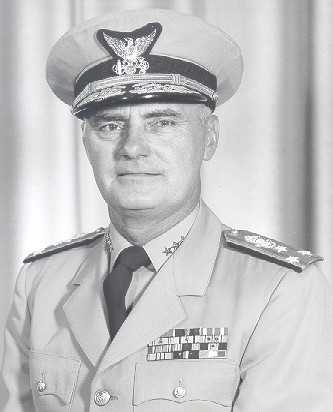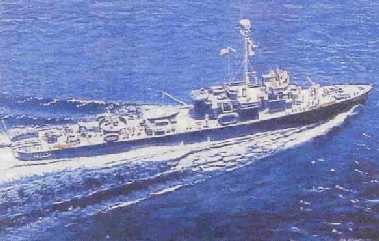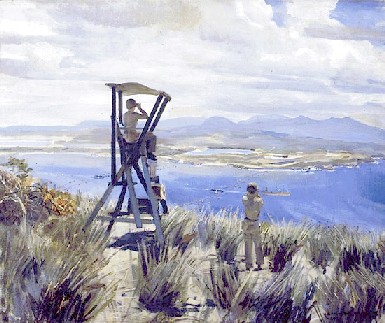U.S. COAST GUARD ORAL HISTORY PROGRAM
USS PC-469: The First Year in the Life of a Valiant Patrol Craft
By Vice Admiral Thomas R. Sargent, III, USCG (Ret.)
Vice Admiral Sargent, a retired Coast Guard flag officer and World War II veteran, graciously provided the Coast Guard Historian's Office with two important publications. They are his first-person accounts of his experiences during World War II while serving as the executive officer and then commanding officer of the USS PC-469 at the height of the battle of the Atlantic and as the "skipper" of the frigate USS Sandusky (PF-54) which served in the Pacific.
"USS PC-469: The First Year in the Life of a Valiant Patrol Craft," provides a unique insight into what it was like to sail aboard a small escort vessel in the Battle for the Atlantic. Here, he and his shipmates escorted vital Allied shipping along the coast and to ports throughout the Caribbean, hunted for German U-boats, and pulled survivors of torpedoed vessels out of the sea. While some of the ports of call visited by PC-469 sound exotic, Sargent and his men rarely got to enjoy their stay--they were constantly in demand and therefore were constantly at sea. The reader will come away from VADM Sargent's story with a great understanding of what it was like to man a warship with a young and inexperienced but highly motivated crew during a critical phase of the Battle of the Atlantic.
Thank you Admiral!
Editor.

Vice Admiral Thomas R. Sargent III, USCG (Ret.)
[190711-G-G0000-2003]
Vice Admiral Thomas R. Sargent III, USCG (Ret.) graduated from the Coast Guard Academy in 1938 and served a good portion of his long and distinguished career at sea aboard the cutters Modoc as a line officer and her assistant engineer, Duane (WPG-33) as her chief engineering officer, and Bibb (WPG-31) as her executive officer. He commanded Winnebago (WPG-40) as well as the Navy warships USS PC-469, serving first as her executive officer, and USS Sandusky (PF-54) during World War II. His shore assignments include the Coast Guard Academy as Maintenance Officer, service as the Chief, Civil Engineering Section of the 11th and then the 9th Coast Guard districts; Chief, Civil Engineering Division at Coast Guard Headquarters, where he supervised the development and construction of the LORAN station chain in Thailand and Vietnam; and as Chief, Operations Division of the 11th Coast Guard District. He was promoted to the rank of Rear Admiral on 1 July 1967 and served as the Commander of the 11th Coast Guard District and then as the Chief of Staff of the Coast Guard at Coast Guard Headquarters. He was promoted to the rank of Vice Admiral on 26 May 1970 and served as the Assistant Commandant (the title of that office was changed to Vice Commandant on 2 October 1972) and he retired on 1 July 1974. His decorations include the Distinguished Service Medal, the Legion of Merit and the Bronze Star with combat "V" device.
They were called "PC's" and they came into being during the first year of World War II - small, fast, maneuverable, rough in any sea and unkind to those who manned them. Yet, although not well recognized in Naval history, they performed with distinction in every theater and performed every duty assigned efficiently and well. The Coast Guard manned and operated four of these unusual ships - PC-469, PC-545, PC-556 and the PC-590. All were commissioned in 1942.

A PC underway, courtesy of the author.
[190711-G-G0000-1001]
Commander William J. Veigele, USNR (Ret) in his book "PC PATROL CRAFT OF WORLD WAR II" has written, with unparalleled detail, a fascinating history of these vessels and the services they performed - this short tome is merely an adjunct to this outstanding work and describes the first year in the life on one of the first to be commissioned.
During May 1942, I was a lieutenant assigned as Executive and Engineer Officer of the USS PC-469 at the George Lawley Shipyard in Neponset, Massachusetts. Three other officers were assigned - Lieutenant Commander Richard Morell as the Commanding Officer with Lieutenant (junior grade) Kenneth Potts and Ensign Richard Young as watch officers. Upon arrival, I became very familiar with the PC design since the ship was in the throes of final outfitting and on the building ways - the keel having been laid on 22 October 1941. The following is a short review of the ship's characteristics: Length 173' 8" with a 23' beam and a full load displacement of 450 tons; maximum speed was 21 knots - twin screw with three bladed props, 6 feet in diameter; propulsion consisted of two Fairbanks Morse, ten cylinders, opposed piston diesels with a total shaft horsepower of 2,280; armament consisted of two 3-inch 50-caliber guns, five 20mm machine guns, two K-guns, and two stern-mounted depth charge racks. A gyrocompass, radio direction finder and sonar gear were installed. Our complement was four officers and 55 enlisted men. Most of the other PC's had five officers but, in our case, only the CO was spared a watch. My duties were four-fold - I was Executive Officer, First Lieutenant. Engineer Officer and Watch Officer. I had little time to spare but the other two officers took care of gunnery, commissary, morale and education and training.
On 10 June 1942, the PC-469 was launched and we started in earnest getting the ship ready to sail. Prior to commissioning, we took her out for sea trials and during a speed calibration run while I was in the engine room I noticed the starboard engine slowing down. While I was checking the cylinder head temperatures, there was a crankcase explosion and I immediately secured the engine. Chief Motor Machinist's Mate Elvyn Kelly and I cleared the engine room of all others while we operated the remaining engine and cleared the white, acrid smoke from the department. Upon return to the shipyard, the No. 1 cylinder liners and the two pistons were replaced and a blockage removed from the oil filter. With that accomplished and tests proving all was well; we placed the ship in commission without ceremony- just started the deck log.
Orders were received to proceed to New York and moor at Staten Island. While in New York, we operated offshore where we tested guns, perfected our anti-submarine organization and replenished our ammunition supplies at Fort Hamilton. We were ordered to Miami, Florida, after the completion of an anti-sub sweep off the entrance of the Harbor. Early in the morning, a very large ship appeared escorted by three destroyers - we identified the ship as the Queen Mary. We were released and sailed to Miami. Even during our short time at sea, it was evident that our Kleinschmidt electric evaporator was of insufficient capacity to allow showers and strict conservation was necessary. As soon as we cast off lines, we imposed "water hours" and, with our assignment to the sub-tropics, the crew and officers became quite "ripe" even after a few days at sea. Ventilation in the sleeping quarters was fair but the living conditions were very crowded. The crew made the best of it and settled down to the established routine with relative ease.
We arrived in Miami about 15 August, moored at the Sub Chaser Training Center and entered our shake down training routine - sailing each day to carry out the various drills necessary to make us an accomplished convoy escort. Machine guns were installed on the bridge wings to complete our armament. During our short in port periods, all officers, deck petty officers and sonar men trained on the anti-sub trainer - all of us did quite well!
On 2 September, we sailed, opened our orders, rendezvoused with a convoy and headed for Key West arriving there shortly after 0800 the following day - mooring at the Naval Operating Base pier 2. On 4 September we had the first opportunity to actually make sonar runs on a submarine in the sub training area off Key West. We found that our two sonar-men, Merrill S. Anderson and Louie Hamilton, were probably the best the Navy sound school instructors had seen. It will be proven that these Instructors were correct!! Training and short convoys continued until 11 September when we were ordered to a convoy assembly area and started our first convoy, which was to end at Guantanamo Bay, Cuba.

Guantanamo Bay, 1943. A painting by Stephen Crane Hill - from the Navy Historical Art Collection.
[190711-G-G0000-9001]
We arrived on the afternoon of 14 September after an uneventful trip and, after fueling, moored alongside the USS PC-474 at Pier B, NOB, Guantanamo. Training continued for the next two days - small arms and anti-sub occupied most of the time. On 17 September, we again sailed as escort for a convoy to Key West. It was an uneventful trip except for one sub contact on my watch on 20 September. I dropped depth charges and fired the two K-guns with no apparent result although contact was not made again. We arrived at Key West in the afternoon and again moored at NOB. Five days later we were again underway with a convoy heading for Guantanamo Bay. The trip was again uneventful and the crew took the heat, the boredom in stride and performed excellently. They even became used to the violent action of the ship in a seaway!! We arrived on 23 September and remained at NOB occupied with training and ship's work until 27 September when we were assigned a convoy heading for Trinidad, BWI, which, we soon discovered, was to be our new homeport.
The rainy season was upon us and keeping station on the convoy during heavy rain- storms was difficult and disconcerting - without radar, extra vigilance was required. We also discovered that submarine contacts were more prevalent so that the crew was deprived of sleep. This resulted in injury to one member of the crew who was too enthusiastic in running to his station. We contacted the USCGC Unalga (WPG-53), one of the other escorts, and the ship's doctor treated him and placed him on light duty for a considerable period.
We arrived in Teteron Bay early afternoon 3 October and moored at the U. S. Navy Section Base transferring our injured crewman, Eugene H Soltys, Yeoman 3/c, to the Naval Hospital for treatment of possible spinal injury. We also granted liberty to one section to expire at 0100, 4 October. LCDR Morell and LT(jg) Potts also went on liberty to Port of Spain leaving ENS Young and me to prepare for departure with a convoy on 6 October.
Since I had been on duty since 0400 on 3 October, I was preparing to retire when a telephone call summoned me to the Operations Office where I was informed that an Army aircraft had bombed a submarine near the Orinoco Delta. A surface vessel was required to possibly determine the status and/or complete the sinking. There was some consternation on the part of the Escort Vessel Administrator when he realized that I was not the CO but I assured him I would sail at midnight even if the commanding officer had not returned from liberty. To arrive at the position at first light made it essential to sail at that time.